Michael Peña & Director David Ayer Talk ‘End of Watch’
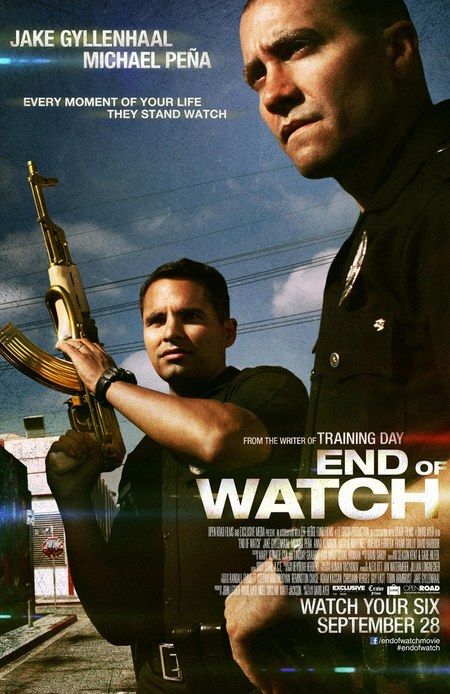
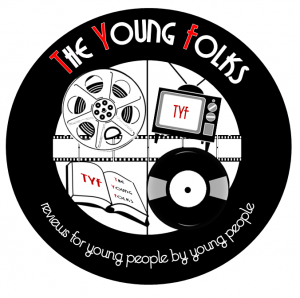 By Gabrielle Bondi, The Young Folks
By Gabrielle Bondi, The Young Folks
Growing up in a blue-collar neighborhood in Chicago, I was surrounded by people who were police officers, firemen, etc. But the thing was… I hardly ever saw them on-duty, or even in uniform. To me, they were hard-working people, just like anyone else. They weren’t like the characters you see on TV or in movies. In fact, I had never seen a movie that as closely captured what I saw from my neighbors or friends’ parents until I saw End of Watch.
After writing several films about corrupt cops (most notably Training Day), director David Ayer spoke about changing it up, “With Training Day and corruption, no one was really doing movies like that. Gangster cops were new. Then, we get 10 years of that. And now to flip it again, it’s like ‘Look at the way cops really are.’ I want to make the most realistic cop movie ever.”
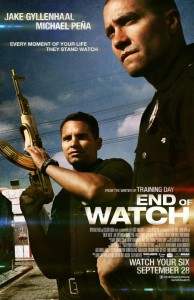 That’s what Ayer did with End of Watch. The film follows two LAPD officers, Brian Taylor (Jake Gyllenhaal) and Mike Zavala (Michael Peña), as they police the dangerous streets of LA. After an encounter with a notorious cartel, their lives on put on the line as they become the targets. That’s just only one element of End of Watch. It’s really more of story about these partners, their friendship, and their families. While there are action and lots of intense moments, it’s balanced out with emotional and comedic scenes, as the two joke around or have heart-to-hearts over their own love lives. It’s at these moments when the movie truly shines. When I told Ayer this, he agreed, describing his favorite scene of the film:
That’s what Ayer did with End of Watch. The film follows two LAPD officers, Brian Taylor (Jake Gyllenhaal) and Mike Zavala (Michael Peña), as they police the dangerous streets of LA. After an encounter with a notorious cartel, their lives on put on the line as they become the targets. That’s just only one element of End of Watch. It’s really more of story about these partners, their friendship, and their families. While there are action and lots of intense moments, it’s balanced out with emotional and comedic scenes, as the two joke around or have heart-to-hearts over their own love lives. It’s at these moments when the movie truly shines. When I told Ayer this, he agreed, describing his favorite scene of the film:
“My favorite scene is the scene where Jake asks Mike for advice about getting married. There’s something that’s just so real and so simple about it that you believe it… Everything is talked about in all these indirect ways, the way you do in real life, and the strength of Mike’s character comes through. You realize how solid this guy is. And he’s like the friend everyone wishes they had. And you see how much Jake is wrestling with this question. and not in a Hollywood way, like a personal, real way. I was very happy with how that scene came out.”
If it weren’t for the chemistry between Peña and Gyllenhaal, those scenes wouldn’t have been as good as they were. They were literally in sync with each other, on top of giving such distinct and great performances. The two actors didn’t know each other from before and come from different backgrounds. Peña grew up near the Pilsen area (a pre-dominantly Mexican-American community) in Chicago, while Gyllenhaal grew up in California, with parents who were Hollywood screenwriters and directors. So, how did these two develop such a wonderful onscreen camaraderie? Pena said it took them like “two months” during training to get to know each other and form a bond.
 After seeing the film, you almost can’t deny that they had form a real friendship, all their scenes together came out so naturally. I asked if any scenes were improvised. “98% of it was written. And I always do that in every– like in Crash for instance. There was these little words here and there, little moments, pieces of behavior.” Peña turned to Ayer. “I remember when I told you it’s all about behavior.” Ayer nodded, “I said, ‘Dude, just get in the car and you’ll know what I’m talking about.’”
After seeing the film, you almost can’t deny that they had form a real friendship, all their scenes together came out so naturally. I asked if any scenes were improvised. “98% of it was written. And I always do that in every– like in Crash for instance. There was these little words here and there, little moments, pieces of behavior.” Peña turned to Ayer. “I remember when I told you it’s all about behavior.” Ayer nodded, “I said, ‘Dude, just get in the car and you’ll know what I’m talking about.’”
“Sometimes people just do behavior, and they’re not even doing the scene, which sucks especially for a director, chewing on the toothpick, looking like ‘I don’t know what you’re doing.’ But it’s when you know a scene so well — like the last scene, for instance, was almost word-for-word. That one was so specific,” Peña said. “You know, there were like 5 words probably improvised. And its little things, you just want to paint the picture. We were here for like 5 months, reading those things. Any stuff that was improvised was talked about already time and time again.”
Ayer says that many discoveries were made during the rehearsal process. “A lot of times we would be rehearsing, and stuff would come up, and man, that’s great. And then finally, when I got to set, I’d sit and write that stuff down. So even new material or anything that’s improvisation are all discoveries along the way. So the main characters… it’s hard to mad-lib as a character and have it be relevant and end up in the movie. But these guys knew their characters, and they could speak as the characters. They could do anything as these characters. They were so locked in.” Peña wholeheartedly agreed, saying that he “really felt like the character.” He goes on to say, “As an actor this is one of the truly fulfilling performances that I have done.”
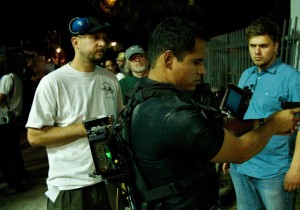 It wasn’t only the two main characters that felt real, but everything and everyone surrounding. Technically, the movie is filmed like “found footage.” It felt and looked like a video game at times. Ayer and crew had to invent new technology in order to get certain camera angles to give off this insanely personal vibe. “Basically, we had to invent a camera system to get some of the photography because in the real world, cops wear these little wearable HD cameras, and I wanted to simulate that. So I took normal cinema camera and had it miniaturized. And then we made vests that these guys could wear, so they’ll run around fighting… You get this point-of-view kind of photography that no one’s been able to get. It’s the idea that cameras are in the world with these people and characters. There are a couple scenes where Jake shot on a handheld consumer camera.” Peña joked that at times he forgot he was even in the movie because of the way it was filmed.
It wasn’t only the two main characters that felt real, but everything and everyone surrounding. Technically, the movie is filmed like “found footage.” It felt and looked like a video game at times. Ayer and crew had to invent new technology in order to get certain camera angles to give off this insanely personal vibe. “Basically, we had to invent a camera system to get some of the photography because in the real world, cops wear these little wearable HD cameras, and I wanted to simulate that. So I took normal cinema camera and had it miniaturized. And then we made vests that these guys could wear, so they’ll run around fighting… You get this point-of-view kind of photography that no one’s been able to get. It’s the idea that cameras are in the world with these people and characters. There are a couple scenes where Jake shot on a handheld consumer camera.” Peña joked that at times he forgot he was even in the movie because of the way it was filmed.
Another authentic touch to film was the inclusion of female cops. They’re often under-represented or misrepresented in media. It was nice to see Cody Horn and America Ferrera bring two realistic female cops to life in the film. It was important to Ayer that the film showed how diverse the LAPD is. “Some of the badass– some of the best cops out there are these female cops. These badass Mexican-American cops are some hard fucking shit. It’s like ‘you don’t want to fuck with them.”
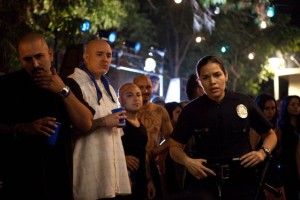 Pena interjected, “Well, they have this great command voice too.”
Pena interjected, “Well, they have this great command voice too.”
Ayer replied, “The mom voice.”
Pena continued, “They have that thing, and they know they have that thing. And especially with criminals, when you see that, you’re like ‘what… the fuck?’ It’s just, it’s kind of…”
“A different kind of power and they know how to use it,” Ayer finished.
One thing I was concerned with, going into the film, was the portrayal of Hispanics and the Latino community. I think movies tend to lean more toward hyperbole than something realistic. I was hoping that since this movie is marketing itself on being authentic, real, and all that, that it wouldn’t disappoint that regard. Fortunately, it didn’t. I asked Ayer how he tried to find that balance between cliché and real life. What many people may not know is that Ayer’s wife is Mexican; he grew up in a Mexican neighborhood, speaks Spanish, and has even lived in Mexico for a time. He said, “It’s part of me. It’s part of who I am. So I understand the culture really well. And it’s not something that I’m putting into it, you know, to add flavor or whatever. It’s something I wanted to express and show people who don’t know the culture. So, all the stereotypes, the quinceañera…” He paused. “ Like Mike’s wife in the movie, Gabby (Natalie Martinez), who’s fantastic, wanted to show a normal guy. He’s just a normal guy. He’s a guy living his life.”
That encompasses almost everything that End of Watch is about. It’s about these normal, average folk that I’ve seen walking their dogs outside, mowing their lawn, chitchatting with neighbors, etc. as I grew up. Then, I loved how it took that and zeroed in on two guys who are best friends, just living the life they have. Going back to when we were talking about the chemistry between Gyllenhaal and Peña, the director put it into perspective. “The whole movie — the whole point of the movie is that friendship. It was the most important thing to me. It was more important than the action, more important than anything else. The best scene in the movie is two guys in a car talking, talking about girlfriends, wives. And it’s riveting. The reason it’s so compelling is because they’re so believable. You believe these guys are best friends. And that they are from different backgrounds is what makes that friendship interesting.” In turn, that’s exactly what made End of Watch one of the most captivating films I’ve seen all year.
End of Watch hits theaters Friday, September 21st.
V
This article was first published in The Young Folks.
Gabrielle Bondi is 22 years old and lives in the beautiful city of Chicago. She enjoys every aspect of the arts, included but not limited to, music, film, literature and drawing. Gaby is very open-minded and adventurous. She likes making outrageous plans and scheming their execution. She usually goes to the movies 2-3 times a week. Yes, she’s that obsessed. She’s also obsessed with Twitter and constantly checking it throughout the day, even when she’s not supposed to…

